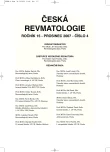Procalcitonin in the diagnosis of bacterial infection in patients with autoimmune rheumatic diseases
Authors:
H. Dejmková 1; K. Pavelka 1; J. Uhrová 2
Authors‘ workplace:
Revmatologický ústav, Praha, 2Ústav klinické biochemie a laboratorní diagnostiky Všeobecné fakultní nemocnice, Praha
1
Published in:
Čes. Revmatol., 15, 2007, No. 4, p. 186-189.
Category:
Overview Reports
Overview
Prognosis of patients with systemic lupus erythematosus is improved due to immunosuppressive treatment. However, the treatment and immunological abnormalities as a consequence of the disease, can contribute to increased risk for serious infections. Discrimination between flare of the disease and infectious complication is difficult. Procalcitonin is a biomarker that is currently used to differentiate systemic inflammatory response of bacterial and non-bacterial etiology in critically ill patients. Sensitivity and specificity of increased procalcitonin levels differ in various studies. This article summarizes the basic data on the role of procalcitonin, particularly its usefulness in rheumatology. Because the level of procalcitonin is rapidly increased by serious bacterial or mycotic infection, but not by autoimmune process or glucocorticoid treatment, we suggest procalcitonin as a valuable surrogate marker to differentiate between those conditions. Furthermore, we assume that combination of procalcitonin (higher specificity) and C-reactive protein (higher sensitivity) assessments together with serum complements C3 and C4 may contribute to discrimination between those two situations that need completely different therapeutical approach.
Key words:
procalcitonin, autoimmune, infection
Sources
1. Cervera R, Khamashta MA, Font J, et al. Morbidity and mortality in systemic lupus erythematodes during a 5-year period. A multicenter prospective study of 1000 patiens. European Working Party on Systemic Lupus erythematodes. Medicine 1999; 78: 167–175.
2. Paton NI. Infections in systemic lupus erythematodes patients. Ann Acad Med Signapore1997; 26: 694–700.
3. Joshua F, Riordan J, Sturgess A. Salmonella typhimurium mediastinal abscess in a patient with systemic lupus erythematosus. Lupus 2003; 12: 710–3.
4. Wu KC, Yao TC, Yeh KW, Huang JL. Osteomyelitis in patients with systemic lupus erythematosus. J Rheumatol 2004; 31: 1340–3.
5. Rovin BH, Tang Y, Sun J, et al. Clinical significance of fever in the systemic lupus erythematosus patient receiving steroid therapy. Kidney Int 2005; 68: 747–59.
6. Zazula R, Průcha M, Spálený A, et al. Prokalcitonin nejen v diferenciální diagnostice zánětlivé odpovědi organismu. Anest Neodkl Péče 2002; 13: 86–91.
7. Selberg O, Hecker H, Martin M, et al. Discrimination of sepsis and systemic inflammatory response syndrome by determination of circulating plasma concentrations of procalcitonin, protein komplement 3a, and interleukin-6. Crit Care Med 2000; 28: 2793–8.
8. Dorizzi RM, Polati E, Sette P, et al. Procalcitonin in the diagnosis of inflammation in intensive care units. Clin Biochem 2006; 39(12): 1138–43.
9. Husová L, Husa P, Šenkyřík M, et al. Prokalcitonin jako indikátor infekce u pacientů s jaterní cirhózou. Vnitř Lék 2004; 50: 153–6.
10. Kazda A in Zima T, et al. Laboratorní diagnostika.1. vyd., Galén, Praha 2002, 829–44.
11. Průcha M, Zazula R, Hyánek J. Prokalcitonin – senzitivní a specifický parametr těžkého bakteriálního zánětu. Anest Neodkl Péče 2002; 3: 83–5.
12. Meisner M. Biomarkers of sepsis: clinically useful? Curr Opin Crit Care 2005; 11: 473–80.
13. Gendrel D, Bohuon C. Procalcitonin as a marker of bacterial infection. Pediatr Infect Dis J 2000; 19: 679–687.
14. Sastre LBJ, Solis DP, Serradilla RV, et al. Procalcitonin is not sufficiently reliable to be the sole marker of neonatal sepsis of nosocomial origin. BMC Pediatr 2006; 6: 16.
15. Assicot M, Gendrel D, Carsin H, et al. High serum procalcitonin concentrations in patiens with sepsis and infection. Lancet 1993; 341: 515–518.
16. Malgorzata A, Verboon-Maciolek, Thijsen SFT, et al. Inflammatory mediators for diagnosis and treatment of sepsis in early infancy. Pediatr Res 2006; 59: 457–61.
17. Meisner M, Adina H, Schmidt J. Correlation of procalcitonin and C-reactive protein to inflammation, complications, and outcome during the intensive care unit course of multiple-trauma patiens. Critical Care 2006; 10: R1.
18. Mokart D, Merlin M, Sannini A, et al. Procalcitonin, interleukin 6 and systemic inflammatory response syndrome (SIRS): early markers of postoperative sepsis after major surgery. Br J Anaesth 2005; 94: 767–73.
19. Elsemmak M, Hanna H, Ghazal A, et al Diagnostic value of serum procalcitonin and C-reactive protein in Egyptian children with streptococcal tonsillopharyngitis. Pediatr Infect Dis J 2006; 25: 174–6.
20. Stolz D, Christ-Crain M, Gencay MM, et al. Diagnostic values of signs, symptoms and laboratory values in lower respiratory tract infection. SwissMed Wkly 2006; 8 (136): 434–40.
21. Don M, Valent F, Korpi M, et al. Efficacy of serum procalcitonin in evaluating severity of community acquired pneumonia in childhood. Scand J Infect Dis 2007; 39: 129–37.
22. Ray P, Badarou-Acossi G, Viallon A, et al. Accuracy of the cerebrospinal fluid results to differentiate bacterial from non bacterial meningitis, in case of negative gram-stained smear. Am J Emerg Med 2007; 25(2): 179–84.
23. Aikawa N, Fujishima S, Endo S, et al. Multicenter prospective study of procalcitonin as an indicator of sepsis. J Infect Chemother 2005; 11(3): 152–9.
24. Jones AE, Fiechtl JF, Brown MD, et al. Procalcitonin test in the diagnosis of bacteremia: A metaanalysis. Ann Emerg Med 2006; (abstrakt PubMed).
25. Martinot M, Sordet C, Soubrier M, et al. Diagnostic value of serum and synovial procalcitonin in acute arthritis: a prospective study of 42 patiens. Clin Exp Rheumatol 2005; 23: 303–10.
26. Bottner F, Wegner A, Winkelmann W, et al. Interleukin-6, procalcitonin and TNF-(alfa): Markers of peri-prosthetic infection following total joint replacement. J Bone Joint Surg Br 2007; 89(1): 94–9.
Labels
Dermatology & STDs Paediatric rheumatology RheumatologyArticle was published in
Czech Rheumatology

2007 Issue 4
Most read in this issue
- Rhabdomyolysis, a brief case report and commentary
- Hip joint destruction and secondary synovial chondromatosis in a patient with rheumatoid arthritis
- Musculoskeletal manifestations in celiac disease
- Procalcitonin in the diagnosis of bacterial infection in patients with autoimmune rheumatic diseases
